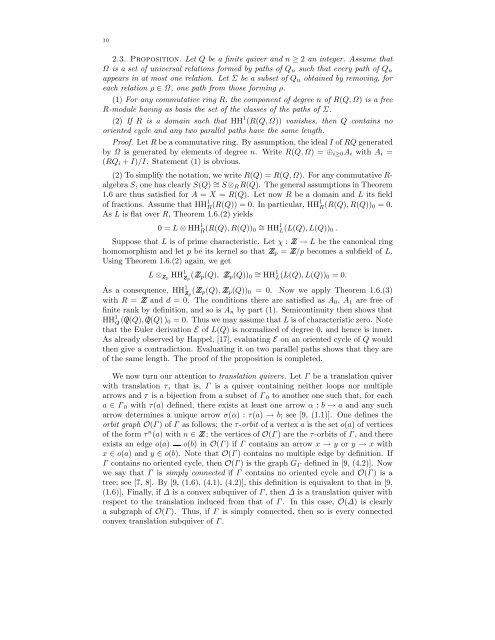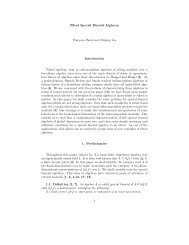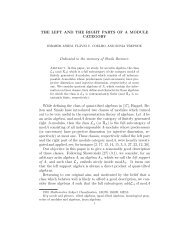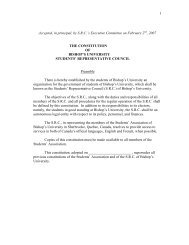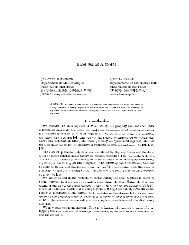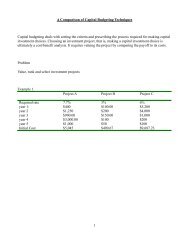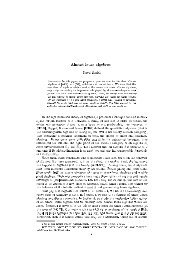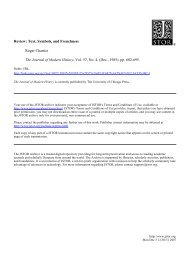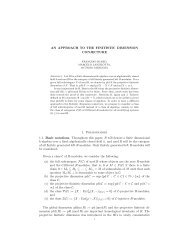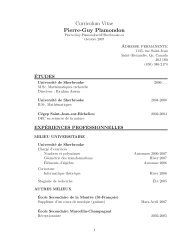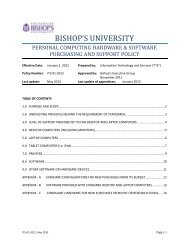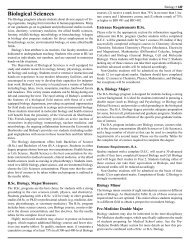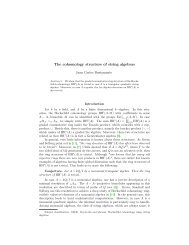Hochschild Cohomology and Representation-finite Algebras Ragnar ...
Hochschild Cohomology and Representation-finite Algebras Ragnar ...
Hochschild Cohomology and Representation-finite Algebras Ragnar ...
You also want an ePaper? Increase the reach of your titles
YUMPU automatically turns print PDFs into web optimized ePapers that Google loves.
10<br />
2.3. Proposition. Let Q be a <strong>finite</strong> quiver <strong>and</strong> n ≥ 2 an integer. Assume that<br />
Ω is a set of universal relations formed by paths of Q n such that every path of Q n<br />
appears in at most one relation. Let Σ be a subset of Q n obtained by removing, for<br />
each relation ρ ∈ Ω, one path from those forming ρ.<br />
(1) For any commutative ring R, the component of degree n of R(Q, Ω) is a free<br />
R-module having as basis the set of the classes of the paths of Σ.<br />
(2) If R is a domain such that HH 1 (R(Q, Ω)) vanishes, then Q contains no<br />
oriented cycle <strong>and</strong> any two parallel paths have the same length.<br />
Proof. Let R be a commutative ring. By assumption, the ideal I of RQ generated<br />
by Ω is generated by elements of degree n. Write R(Q, Ω) =⊕ i≥0 A i with A i =<br />
(RQ i + I)/I. Statement (1) is obvious.<br />
(2) To simplify the notation, we write R(Q) =R(Q, Ω). For any commutative R-<br />
algebra S, one has clearly S(Q) ∼ = S⊗ R R(Q). The general assumptions in Theorem<br />
1.6 are thus satisfied for A = X = R(Q). Let now R be a domain <strong>and</strong> L its field<br />
of fractions. Assume that HH 1 R(R(Q)) = 0. In particular, HH 1 R(R(Q),R(Q)) 0 =0.<br />
As L is flat over R, Theorem 1.6.(2) yields<br />
0=L ⊗ HH 1 R(R(Q),R(Q)) 0<br />
∼ = HH<br />
1<br />
L (L(Q),L(Q)) 0 .<br />
Suppose that L is of prime characteristic. Let χ : Z → L be the canonical ring<br />
homomorphism <strong>and</strong> let p be its kernel so that Z p = Z/p becomes a subfield of L.<br />
Using Theorem 1.6.(2) again, we get<br />
L ⊗ Zp HH 1 Z p<br />
( Z p (Q), Z p (Q)) 0<br />
∼ = HH<br />
1<br />
L (L(Q),L(Q)) 0 =0.<br />
As a consequence, HH 1 Z p<br />
( Z p (Q), Z p (Q)) 0 = 0. Now we apply Theorem 1.6.(3)<br />
with R = Z <strong>and</strong> d = 0. The conditions there are satisfied as A 0 , A 1 are free of<br />
<strong>finite</strong> rank by definition, <strong>and</strong> so is A n by part (1). Semicontinuity then shows that<br />
HH 1 ( lQ(Q), lQ(Q)) Q l<br />
0 = 0. Thus we may assume that L is of characteristic zero. Note<br />
that the Euler derivation E of L(Q) is normalized of degree 0, <strong>and</strong> hence is inner.<br />
As already observed by Happel, [17], evaluating E on an oriented cycle of Q would<br />
then give a contradiction. Evaluating it on two parallel paths shows that they are<br />
of the same length. The proof of the proposition is completed.<br />
We now turn our attention to translation quivers. LetΓ be a translation quiver<br />
with translation τ, that is, Γ is a quiver containing neither loops nor multiple<br />
arrows <strong>and</strong> τ is a bijection from a subset of Γ 0 to another one such that, for each<br />
a ∈ Γ 0 with τ(a) defined, there exists at least one arrow α : b → a <strong>and</strong> any such<br />
arrow determines a unique arrow σ(α) :τ(a) → b; see [9, (1.1)]. One defines the<br />
orbit graph O(Γ )ofΓ as follows: the τ-orbit of a vertex a is the set o(a) of vertices<br />
of the form τ n (a) withn ∈ Z ; the vertices of O(Γ )aretheτ-orbits of Γ ,<strong>and</strong>there<br />
exists an edge o(a) o(b) inO(Γ )ifΓ contains an arrow x → y or y → x with<br />
x ∈ o(a) <strong>and</strong>y ∈ o(b). Note that O(Γ ) contains no multiple edge by definition. If<br />
Γ contains no oriented cycle, then O(Γ ) is the graph G Γ defined in [9, (4.2)]. Now<br />
we say that Γ is simply connected if Γ contains no oriented cycle <strong>and</strong> O(Γ )isa<br />
tree; see [7, 8]. By [9, (1.6), (4.1), (4.2)], this definition is equivalent to that in [9,<br />
(1.6)]. Finally, if ∆ is a convex subquiver of Γ ,then∆ is a translation quiver with<br />
respect to the translation induced from that of Γ . In this case, O(∆) is clearly<br />
a subgraph of O(Γ ). Thus, if Γ is simply connected, then so is every connected<br />
convex translation subquiver of Γ .


